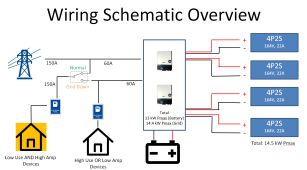JeepHammer
Solar Wizard
- Joined
- Nov 15, 2019
- Messages
- 1,149
USING your small solar/RE power can be fairly aggravating.
And using your small RE power in an emergency can be MORE aggravating since you are in the dark, in an emergency...
I spent some time prior to the big 2012 scare wiring these dual Electrical Grid & Renewable/Back Up IN PARALLEL, This is NOT a Grid-Intertie arrangement.
YOUR SAFETY IS UP TO YOU.
While *I* find this perfectly safe and had no issues in any of the installs I've done, it will drive code inspectors crazy.
YOU will have to decide *IF* and *HOW* YOU will use these ideas.
This requires drilling and running 120/240 Volt wires, but uses common equipment you already have in the home, with very few additions/purchases.
-----------------------------
120 Volt Small Solar/RE outlets in the home so you can use your production by moving you device plugs from Grid To Solar connections...
Every wall outlet you already have has 2 sockets, these sockets are connected by a small tab on the side of the outlet.
The TAB is designed to be broken off so each socket can be powered independently one can be Solar or Emergency, the other Grid powered.
When you want to use your RE, Emergency system, you simply move the Appliance plug to the other socket in the outlet.
You will need to know your outlets, so here is some images/diagrams to help understand what everything is and how to wire it...
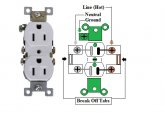
The 'Gold' terminal screws are ALWAYS the 'Line' or 'Hot' terminal, no exceptions.
This is 'Normally' a 'Black' insulated wire in the bundle.
The 'Silver' terminal screws are ALWAYS the 'Neutral' terminal, no exceptions.
This is 'Normally' a 'White' insulated wire in the bundle.
The 'Green' terminal screw are ALWAYS the 'Ground' or 'Earth Ground', no exceptions.
This is 'Normally' a 'Green' or Bare Copper wire in the bundle.
NO MATTER WHAT COLOR the insulation color is, the 'Hot' must ALWAYS go to the 'Gold' screws,
The 'Neutral' must always go to the 'Silver' screws.
The 'Ground' must always go to the 'Green' screws.
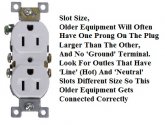
Notice I Show The 'Ground' Terminal At The Top, And This Is How Outlets Are *Supposed* To Be Installed.
The Idea Is, If The Plug Gets Backed Out Leaving A Gap And Something Falls Between Plug & Outlet, The First Thing Contacted Is The Electrical Safety, The 'Ground' Terminal,
And If What Ever Fell In There Contacts The Line Voltage Terminal It Will Trip The Circuit Protection (Fuse or Breaker).
While Not Observed, I Thought You Should Be Aware Of This.
------------------------------------------------------------
This shows the connector TAB between recepticles that MUST be removed.
They are made two ways, one with a slot for screwdriver, the other sticks out so you can grab it with pliers.
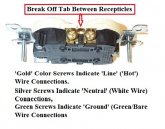
In ANY outlet box (in the wall) will have at least TWO ports to let wires into the box.
It will be up to YOU to drill the holes, run the wire, snake it into the box and connect to your outlet.
there are long/flexible drill bits at the big box stores specifically, and you will find they have a hole in the point,
Tie a string to the point AFTER the hole is drilled and pull that 'Snake' back through when you pull the drill bit out.
That string will let you pull the wire through and up to the box/outlet.
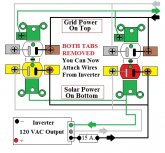
*IF* you have a run of wire more than about 6 Feet, put an AC Circuit Breaker in the wire as close to the inverter as is practical.
This Circuit Breaker MUST be sized to protect the WIRE RUN, not the inverter or appliance.
I show Yellow for using your RE regularly, I show Red for Emergency power set up.
DO PAINT the half of the outlet you have connected to RE or Emergency Backup.
If you have a double outlet, it's even easier...
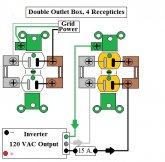
AGAIN, I WOULD USE A DIFFERENT COLOR OUTLET OR PAINT THE RE/EMERGENCY POWER OUTLET.
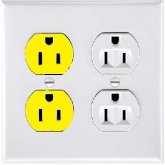
This allows you to use your Renewable Energy PARALLEL to Grid power, If you RE gets too low, simply move the plug to the grid socket.
And using your small RE power in an emergency can be MORE aggravating since you are in the dark, in an emergency...
I spent some time prior to the big 2012 scare wiring these dual Electrical Grid & Renewable/Back Up IN PARALLEL, This is NOT a Grid-Intertie arrangement.
YOUR SAFETY IS UP TO YOU.
While *I* find this perfectly safe and had no issues in any of the installs I've done, it will drive code inspectors crazy.
YOU will have to decide *IF* and *HOW* YOU will use these ideas.
This requires drilling and running 120/240 Volt wires, but uses common equipment you already have in the home, with very few additions/purchases.
-----------------------------
120 Volt Small Solar/RE outlets in the home so you can use your production by moving you device plugs from Grid To Solar connections...
Every wall outlet you already have has 2 sockets, these sockets are connected by a small tab on the side of the outlet.
The TAB is designed to be broken off so each socket can be powered independently one can be Solar or Emergency, the other Grid powered.
When you want to use your RE, Emergency system, you simply move the Appliance plug to the other socket in the outlet.
You will need to know your outlets, so here is some images/diagrams to help understand what everything is and how to wire it...

The 'Gold' terminal screws are ALWAYS the 'Line' or 'Hot' terminal, no exceptions.
This is 'Normally' a 'Black' insulated wire in the bundle.
The 'Silver' terminal screws are ALWAYS the 'Neutral' terminal, no exceptions.
This is 'Normally' a 'White' insulated wire in the bundle.
The 'Green' terminal screw are ALWAYS the 'Ground' or 'Earth Ground', no exceptions.
This is 'Normally' a 'Green' or Bare Copper wire in the bundle.
NO MATTER WHAT COLOR the insulation color is, the 'Hot' must ALWAYS go to the 'Gold' screws,
The 'Neutral' must always go to the 'Silver' screws.
The 'Ground' must always go to the 'Green' screws.

Notice I Show The 'Ground' Terminal At The Top, And This Is How Outlets Are *Supposed* To Be Installed.
The Idea Is, If The Plug Gets Backed Out Leaving A Gap And Something Falls Between Plug & Outlet, The First Thing Contacted Is The Electrical Safety, The 'Ground' Terminal,
And If What Ever Fell In There Contacts The Line Voltage Terminal It Will Trip The Circuit Protection (Fuse or Breaker).
While Not Observed, I Thought You Should Be Aware Of This.
------------------------------------------------------------
This shows the connector TAB between recepticles that MUST be removed.
They are made two ways, one with a slot for screwdriver, the other sticks out so you can grab it with pliers.

In ANY outlet box (in the wall) will have at least TWO ports to let wires into the box.
It will be up to YOU to drill the holes, run the wire, snake it into the box and connect to your outlet.
there are long/flexible drill bits at the big box stores specifically, and you will find they have a hole in the point,
Tie a string to the point AFTER the hole is drilled and pull that 'Snake' back through when you pull the drill bit out.
That string will let you pull the wire through and up to the box/outlet.

*IF* you have a run of wire more than about 6 Feet, put an AC Circuit Breaker in the wire as close to the inverter as is practical.
This Circuit Breaker MUST be sized to protect the WIRE RUN, not the inverter or appliance.
I show Yellow for using your RE regularly, I show Red for Emergency power set up.
DO PAINT the half of the outlet you have connected to RE or Emergency Backup.
If you have a double outlet, it's even easier...

AGAIN, I WOULD USE A DIFFERENT COLOR OUTLET OR PAINT THE RE/EMERGENCY POWER OUTLET.

This allows you to use your Renewable Energy PARALLEL to Grid power, If you RE gets too low, simply move the plug to the grid socket.
Last edited:






